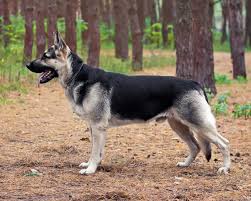
East European Shepherd
Conditions of detention
The East European Shepherd is adaptable but thrives in environments with ample space to exercise, such as a large yard or rural setting.
Useful Fact: They can live in apartments if sufficiently exercised but prefer larger spaces where they can roam freely.
Nutrition and diet
A balanced diet of high-quality commercial dog food, rich in protein and fats, is essential for maintaining their health and energy levels.
Useful Fact: Due to their large size, it’s important to monitor their diet to prevent obesity, which can lead to health problems.
Health
The East European Shepherd is generally healthy but can be prone to hip dysplasia and other genetic conditions common in large breeds.
Useful Fact: Regular veterinary check-ups and maintaining a healthy weight can help mitigate potential health issues.
Grooming and care
The East European Shepherd has a thick double coat that can be short to medium in length. Coat colors typically include black and tan, sable, or solid black. Regular brushing is necessary to manage their coat, especially during shedding seasons.
Useful Fact: Bathing should be done only when necessary to avoid stripping natural oils from their coat.
Education and training
They are intelligent and trainable, excelling in obedience and working roles with consistent and positive reinforcement training.
Useful Fact: Early socialization and training are crucial for developing a well-rounded and well-behaved dog
Toys and entertainment
Interactive toys and activities that challenge their intellect and provide physical exercise are ideal.
Useful Fact: Engaging them in tasks and games can help prevent boredom and destructive behavior.
Safety
Ensuring a secure and safe environment is important, as their protective instincts can lead them to be territorial.
Useful Fact: Proper fencing and supervision during outdoor activities can prevent unwanted incidents.
Accessories
Durable leashes, collars, and harnesses are essential, along with comfortable bedding and crates for rest.
Useful Fact: Using a harness can provide better control during walks and reduce strain on their neck.
Socialization
Early and ongoing socialization with different people, animals, and environments is crucial to prevent aggression and fearfulness.
Useful Fact: Regular playdates and exposure to various settings can help them develop into confident and friendly dogs.
Travel and Transportation
Accustomed to traveling, they need secure crates or harnesses for safety during car trips.
Useful Fact: Gradual acclimation to travel can make them better companions on long journeys.
Behavior and psychology
East European Shepherds are loyal, protective, and intelligent, often forming strong bonds with their families.
Useful Fact: Understanding their need for companionship and mental stimulation can help manage their behavior effectively.
Legal aspects
Owning an East European Shepherd may come with legal responsibilities, such as adherence to leash laws and breed-specific regulations.
Useful Fact: Familiarizing yourself with local laws and regulations regarding large breeds can prevent legal issues.


